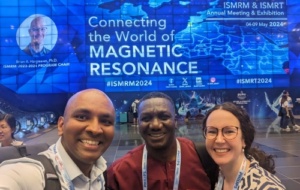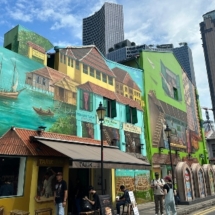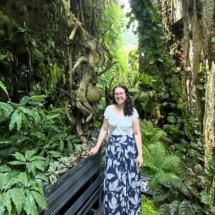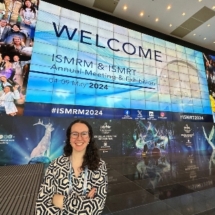ISMRM Conference 2024
 Old Members’ Trust Graduate Conference and Academic Travel Fund Travel Report – Bronwyn Gavine (2019, DPhil in Clinical Neuroscience)
Old Members’ Trust Graduate Conference and Academic Travel Fund Travel Report – Bronwyn Gavine (2019, DPhil in Clinical Neuroscience)
It was a great privilege to attend the 2024 International Society for Magnetic Resonance in Medicine conference (which is quite a mouthful, so ISMRM for short!). The conference was held over the course of a week in May, in the bustling city-state of Singapore.
ISMRM is an incredibly unique conference, which brings together healthcare workers and scientists across a broad range of fields – radiographers, physicists, imaging scientists, and doctors with all manner of specialisms (from neurology to intensive care to cardiology); who all work on different aspects of MRI research. While many medical conferences focus on a specific body system, or even a single disease, ISMRM includes research on all systems, paediatric and adult, as well as technical development of new or improved MRI sequences, safety aspects, and a huge amount more. With thousands of attendees from all over the world, and an exciting but vast programme with ~9 streams for each programme slot, I was braced for a busy and overwhelming time. However, I found the conference to be exceptionally friendly and community orientated – with welcome events for those of us new to the conference, smaller social events for groups with similar interests, and many fascinating discussions around the coffee stands during breaks.
 I was able to present one of my DPhil projects, which utilised MRI to analyse the white matter tracts of children with cerebral palsy, to look for biomarkers that would predict treatment response. This project was the culmination of many years of hard work, and I was delighted to have many stimulating conversations during my presentation, to mull over as I write my dissertation.
I was able to present one of my DPhil projects, which utilised MRI to analyse the white matter tracts of children with cerebral palsy, to look for biomarkers that would predict treatment response. This project was the culmination of many years of hard work, and I was delighted to have many stimulating conversations during my presentation, to mull over as I write my dissertation.
While it was sometimes challenging to pick from the range of sessions, some highlights of talks attended include a panel discussion on democratising MRI, with panellists exploring the challenges and successes of implementing technology in resource-constrained regions. As a South African doctor, I found this talk especially poignant: in the hospital I worked at before coming to Oxford, we had 1 MRI scanner for a population of 3.5 million people. As a comparison, Oxford University has 9 research MRI scanners and approximately 5 clinical MRI scanners, for a population of ~150 000!
Finally, there was a lot of interest in new developments of low field MRI, which makes scanners cheaper and more portable; but has historically been of lower quality and therefore more difficult to interpret. However, new advancements in the field have allowed for better quality images, and, importantly, has improved access to MRI, enabling MRI research to start to be done in more rural and remote areas.
Whilst the conference programme was extremely full, I did manage to explore some of the districts of Singapore, sampling delicious food and enjoying the sights. I particularly enjoyed the Gardens by the Bay, an impressively landscaped waterside oasis, with the largest glass greenhouse in the world!
The final night of the conference was hosted at the F1 racing circuit, and I was delighted to run into Professor Godwin Ogbole, a Nigerian radiologist who was previously an academic visitor at University College, and Professor Jezzard, a giant in the field of MRIA, and also the Vice-Master of the college.
It was a fantastic conference which was immensely enriching academically and professionally, and I am very grateful to University College for their support.
Published: 16 August 2024



